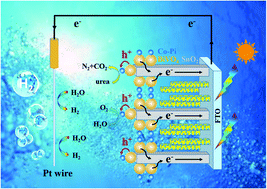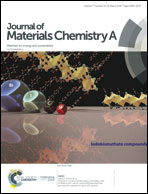Directed synthesis of SnO2@BiVO4/Co-Pi photoanode for highly efficient photoelectrochemical water splitting and urea oxidation†
Abstract
To achieve highly efficient photoelectrochemical (PEC) water splitting, great efforts have been dedicated to develop various photoelectrode materials in pure water electrolytes. Recently, some studies are turning to hydrogen production from seawater or wastewater, to save valuable freshwater resources and make waste profitable. Here, we fabricate one-dimensional SnO2@BiVO4 core–shell nanorod arrays decorated with cobalt-phosphate cocatalyst (1D SnO2@BiVO4/Co-Pi NRAs), which show efficient charge separation and transport properties due to the rational design of conducting core-layer and introduction of the cocatalyst. The as-obtained SnO2@BiVO4/Co-Pi photoanodes exhibit largely enhanced PEC water oxidation performance: the maximum photocurrent density of 2.63 mA cm−2 at 1.23 V vs. RHE is 6.58 times higher than that of pristine BiVO4 films (∼0.40 mA cm−2). Moreover, the ternary photoanode exhibits promising PEC performance for urea oxidation, giving rise to a current density of 3.44 mA cm−2 at 1.23 V vs. RHE in a neutral urea electrolyte. This work presents a sunlight-driven, eco-friendly and sustainable method to produce hydrogen and simultaneously treat urea-rich wastewater.



 Please wait while we load your content...
Please wait while we load your content...